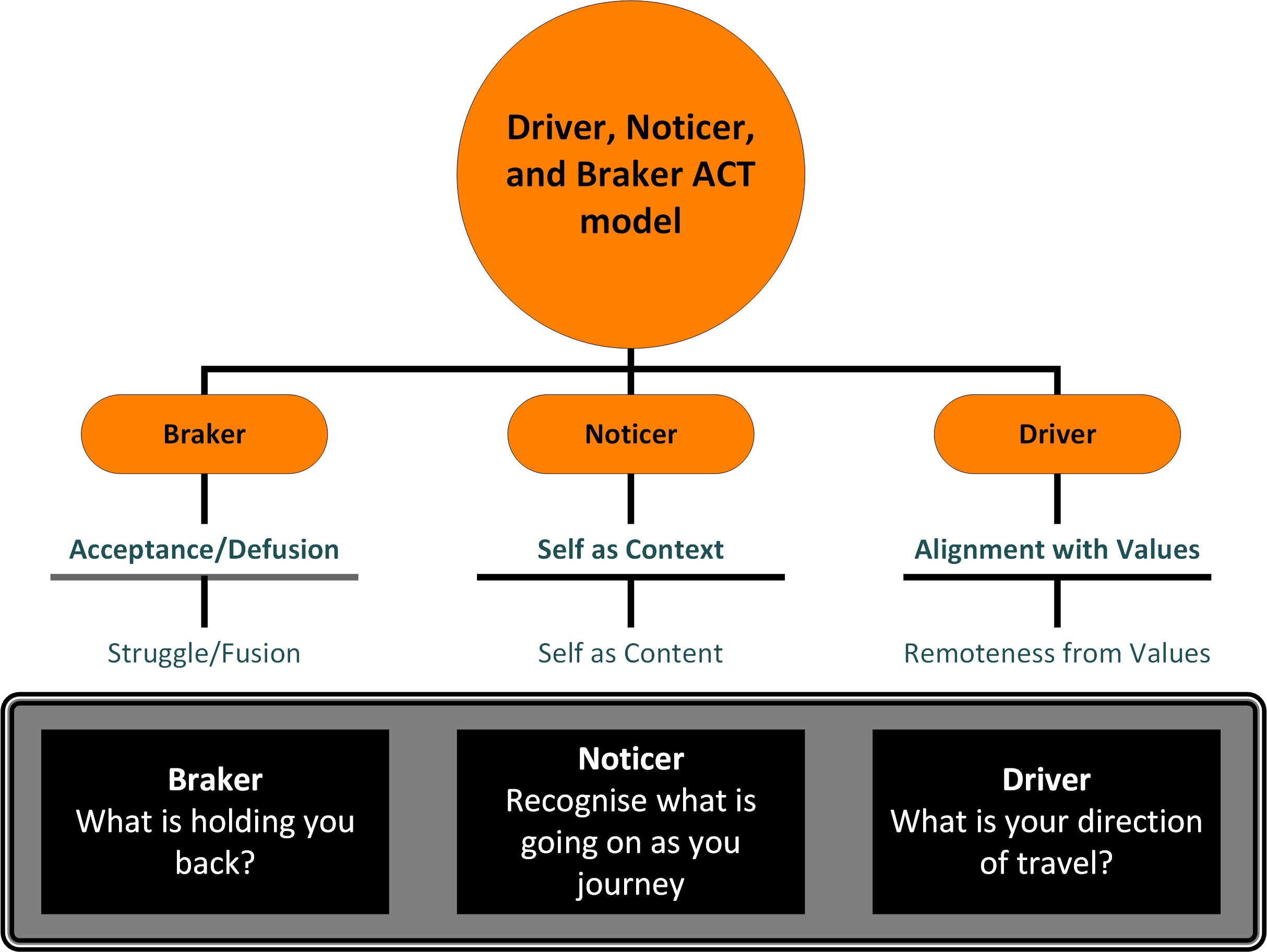COVID-19
2020 has been a difficult year for a huge number of the population.
Whether you’ve been directly impacted by the disease or not, we all will have had some psychological response to the events of this year. To help you through understanding your response, and more importantly, to help you move forward through the global pandemic we have provided a dedicated page of resources to help you look forward to your future.
What is ACT?
Psychological Flexibility
ACT (Acceptance Commitment Training/Therapy) is one of the more recent mindfulness-based behaviour therapies. ACT does not attempt to remove pain, because, whether we like it or not, pain is part and parcel of everybody’s life.
At the heart of ACT is a concept of “Psychological Flexibility”. So it can be said the main aim of ACT is to achieve a greater level of psychological flexibility. But what does that mean?
Psychological Flexibility is defined as being able to have difficult and unwanted thoughts and feelings, while still engaging in all those things that make life meaningful.
The opposite of flexibility is ‘rigidity’ or ‘inflexibility’. Behaving in a psychologically rigid or inflexible way means that we attempt to deal with difficult issues in a most unhelpful way: by avoiding the issue.
By turning away from the issue we hope to avoid ‘feeling bad’.
Unfortunately, this ‘simplistic solution’ does not consider that life is complicated and often painful. So, if our main aim in life is to avoid pain, we cannot learn new ways for dealing with life and we do not grow as people. By ignoring the fact that mistakes are part of learning and that failure often is our companion on the pathway towards success, we forget that this comes at a cost: The price for trying to avoid pain is additional suffering.
While pain is part of every life, ACT increases psychological flexibility by teaching ways that decrease additional emotional suffering:
ACT teaches us that our goal in life is to live a full and meaningful life. The goal of life is not to avoid pain but to live life.
ACT promotes psychological flexibility, by teaching new skills that we can apply to deal with life in new ways.
ACT enhances resilience by teaching us to drop the battle with our thoughts and feelings.
ACT clarifies what we value in life and therefore gives guidance and direction to our actions.
ACT is trans-diagnostic*) and non-labelling. It takes a contextual**) approach to life and increases pro-social***) behaviour. As a consequence, ACT can be helpful in many settings: one-to-one counselling, mental health and corporate training, team building, decision making, and coaching.
Click on the button to right for a non-Professional Introduction to ACT and ACT processes using the Driver, Noticer, Braker Model or read on for a more in depth look at the model
Driver Noticer and Braker ACT Model
Developed by Daniel Farmer, adapted from the ACT Tri-Flex (Dr Russ Harris) and the ACT Matrix (Dr Kevin Polk).
The goal of ACT is to promote PSYCHOLOGICAL FLEXIBILITY.
Having flexible thinking in the face of adversity. Recognising that it is possible to have flexible thinking even when our minds are telling us to behave in a certain way. Having awareness that we do have choice.
ACT, whilst made up of a number of constituent parts, is ultimately a Process. It does not try to directly change our view of a situation, challenge or suffering that we are experiencing; rather the Process may help us to change our relationship with whatever is causing our suffering.
The model below is a metaphor for life. We are all the pilots (drivers) of our own lives. There are 3 discreet elements to the model:
The Driver element: hands on the wheel setting the course or direction.
The Noticer element: the awareness of the journey and what is going on inside and outside the vehicle.
The Braker element: ready to slow up the vehicle if things get a bit scary.
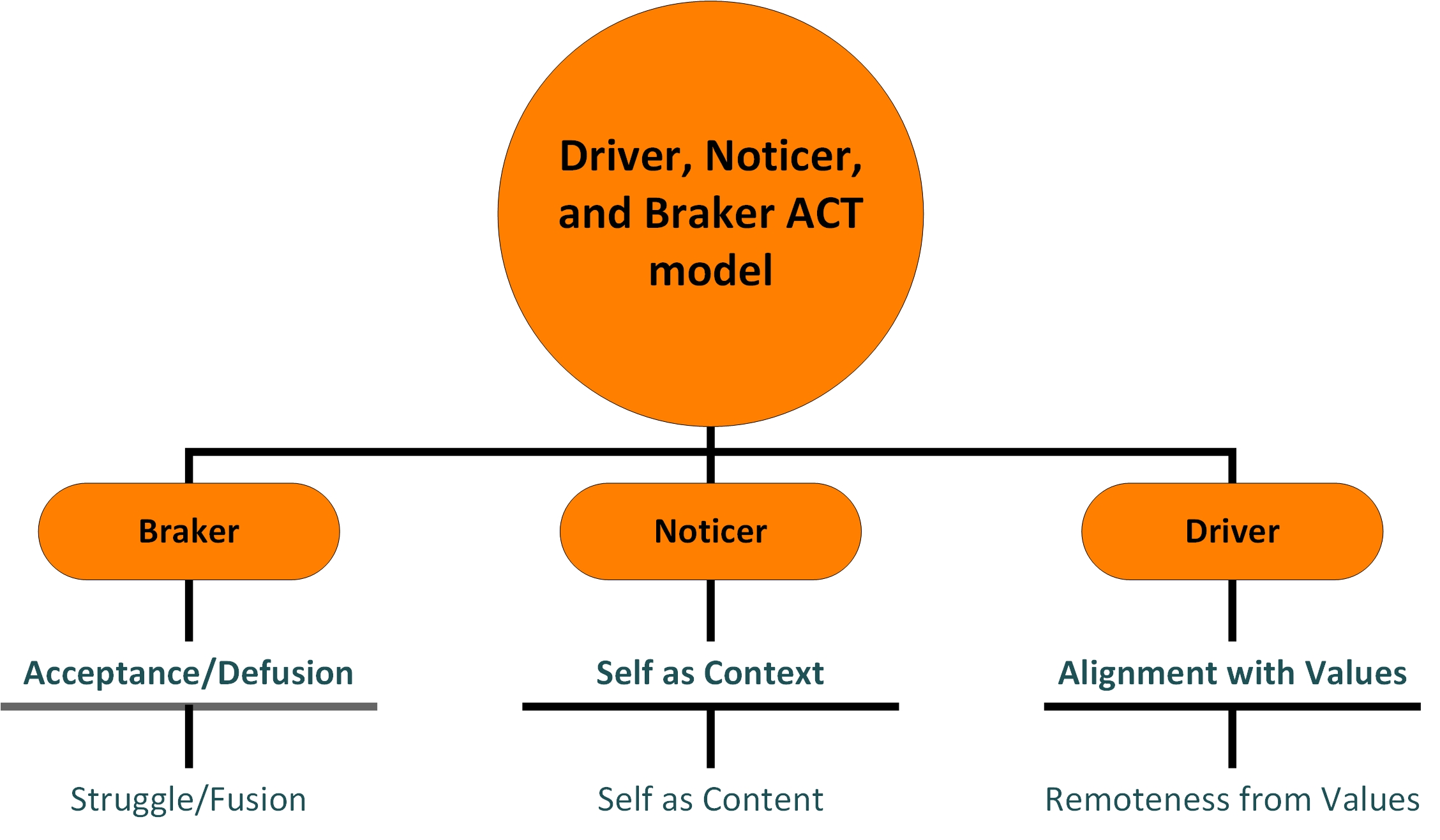
The Driver
The driver is the person with their hands on the wheel directing where we need to go.
Ask yourself the question: “who and/or what is important to you?”
“It’s not hard to make decisions once you know what your values are ” Roy E. Disney
“Who/What is most important to you in your life? ”: A simple yet liberating question.
Once you know this you can start to take committed ACTion in the service of these Values.
The Noticer
When driving we need to notice what is going on around us in the present moment so that we can respond appropriately to it.
The noticer is the part of us that has awareness.
This awareness may be in the present when we are engaged in challenging activity such as playing a sport; or it may be focused on the content of our minds such as when we are ruminating over a past event or ‘time-travelling’ into the future by playing out possible scenarios in our minds.
Whilst there is nothing necessarily wrong with either of these – indeed thinking back on past events and planning for the future are important as they help to make sense of our lives and direction of travel – the problem occurs when we become so invested in these we cease to live in the moment, get swept up in our thoughts so much that we lose connection with the now. Remember the only time we ever have is right now.
In ACT we learn to connect to the present moment in order to cultivate awareness of thoughts, feelings, and emotions in any given moment.
If we can notice something happening, we create an opportunity for choice in how we behave and respond.
The Braker
Whilst sometimes it is important to use the brakes in life it’s not usually helpful to try and press the accelerator and brake at the same time.
Even when people have identified what is important to them (who/what is important) they are often unconsciously held back from living in line with them as it may feel overwhelming to even try. We refer to this as Fusion (fusing with our thoughts as if they are real) and Non-Acceptance (avoidance); these are the mental blocks that can hold us back.
Life is challenging no matter who you are and trying to avoid the scarier experiences of it (what we call experiential avoidance) is likely to have poor long-term outcomes.
ACT tells us to turn towards what we fear through Acceptance and Defusion.
To do this we need to actively turn towards discomfort; be bold, be with the discomfort and you will likely find that it’s two-dimensional and paper thin. Accept that you are uncomfortable and be genuinely curious about it. This is Ultimate (Radical) Acceptance .
To (slightly mis) quote Shakespeare “Nothing is good or bad until the mind makes it so ”. The reality is our minds often decide on whether something good or bad immediately after having a thought.
This is often down to life experiences, upbringing and cultural and/or religious beliefs. Remember we do have Choice over how we respond to both internal and external experiences.
Driver
Who/What is Important
Our guiding light on what is most important to us.
Noticer
Awareness
Present moment awareness; noticing what and how we are thinking
Braker
Acceptance
Recognise what is holding us back and ease up on that brake. Turn towards suffering.
REMEMBER: We never try to directly influence or control the content of our minds in ACT; rather we recognise that thoughts and feelings exist, choose to accept and/or defuse them using defusion and re-framing techniques. There are links to YouTube videos and various documents on the Resources page
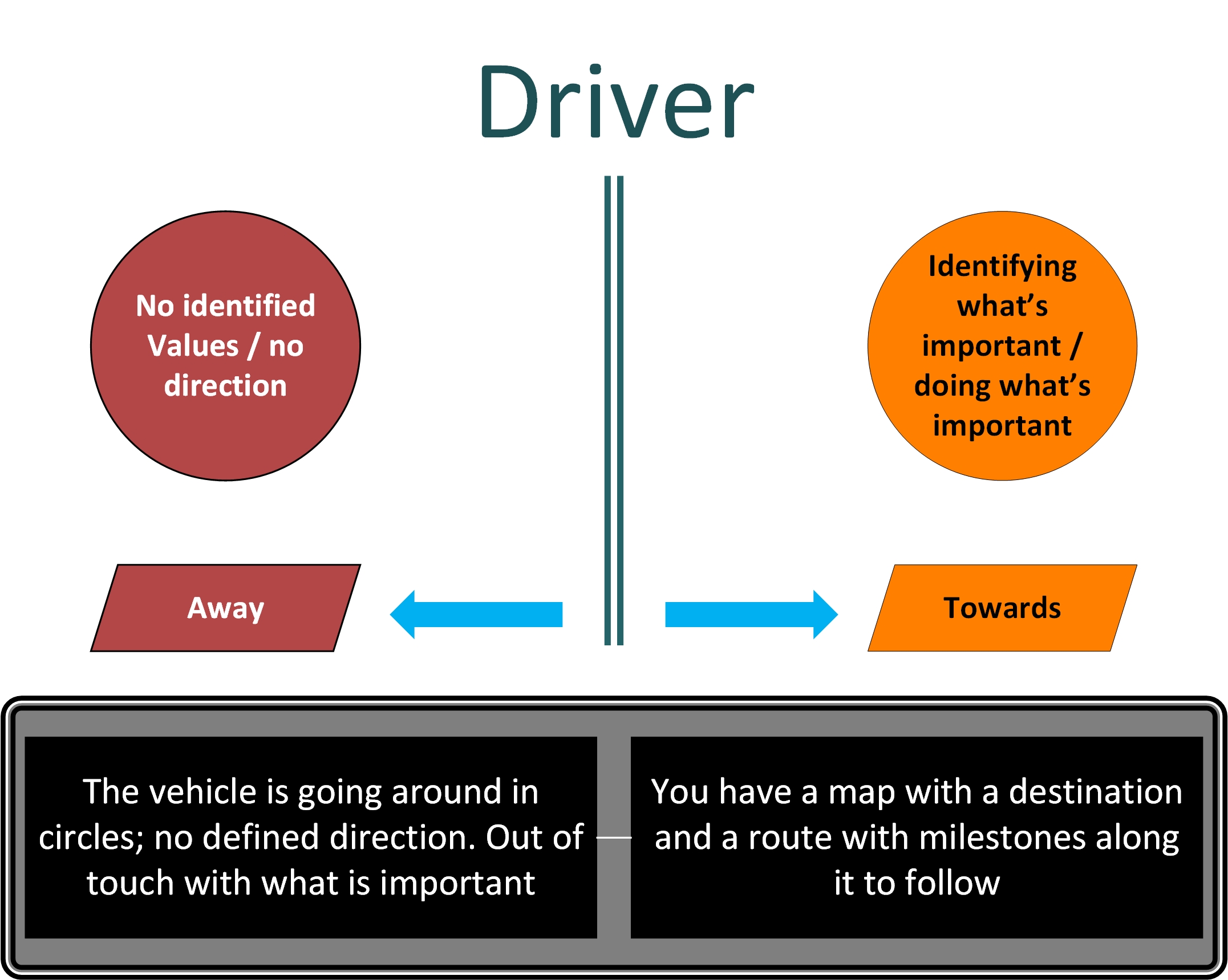
Remoteness from Values OR Alignment with Values
“Who is most important to you in life”. This is always a good question to ask yourself when venturing into ACT. If you do not know what is most important to you in life you will be directionless.
Even though we may hold many values at this time ask yourself “Who is most important to me” . This is not a right or wrong answer and could (and should) be a number of people.
A value is like heading West; a goal is like the river or mountain or valley we aim to cross whilst traveling in that direction. Goals can be achieved or ‘crossed off’, whereas values are ongoing. (No matter how far West you go, you never reach it!) For example, if you want to be a loving, caring, supportive partner, that is a value: it involves ongoing action. In contrast, if you want to get married, that’s a goal – it can be ‘crossed off’ or achieved. If you want a better job, that’s a goal. Once you’ve got it – goal achieved. But if you want to fully apply yourself at work, contribute your best, and engage fully in what you’re doing, that’s a value: it involves ongoing ACTion.
Once you have clarified your values you have a direction of travel along which there will be milestones. These are your goals and actions which are in service of your values. This is Committed ACTion. Commit to it and do it. The mind may tell you it is too hard or too much – this is the Braker : use acceptance and defusion techniques to minimise the impact of these unhelpful thoughts and feelings.
Remember that a journey of a thousand miles begins with a single step: we all must start somewhere.
Having said that it is possible to set goals which are unrealistic given existing personal circumstances and resources. It is often worthwhile checking whether goals are achievable using SMART. In the Resources page there is a section on SMART which has an ACT variation.
Check in regularly to make sure that that you living in line with those values.
Deep down inside ask yourself:
• Who/What is important to you?
• What do you want your life to stand for?
• What sort of qualities do you want to cultivate as a person?
• How do you want to be in your relationships with others?
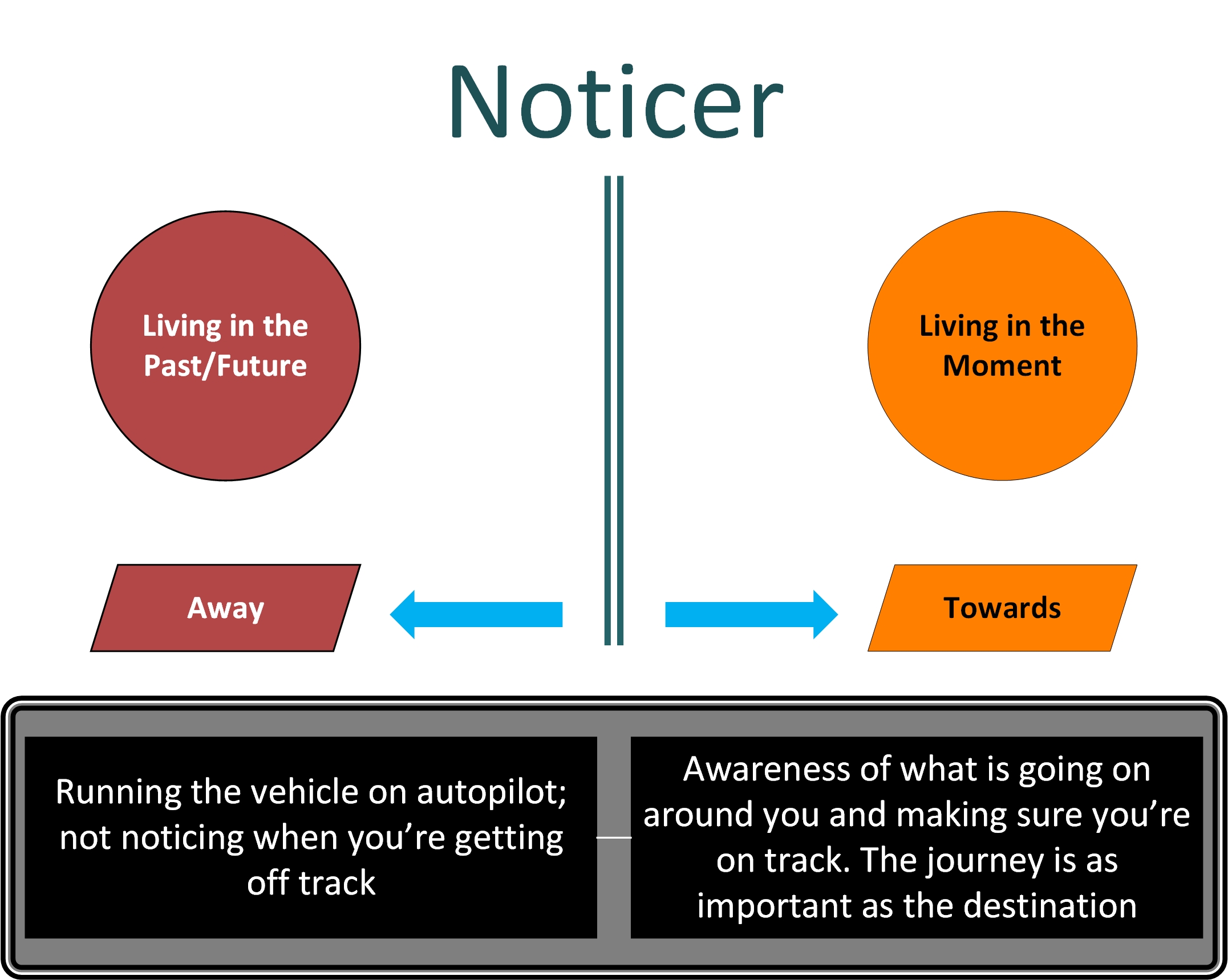
Self as Content (caught up in thoughts and feeling) OR Self as Context (living in the present moment)
The noticer is the part of us that has awareness. Part of the ACT process is to cultivate awareness of what is going on for us at any one moment. Without this awareness how do we know when we are getting carried away by our thoughts, feelings, and emotions.
When we talk about mindfulness we are not talking about anything that is necessarily spiritual or even formal, such as meditation.
All it takes is some regular practice.
Once some awareness has been developed we are able to start seeing our thoughts for what they are: mental processes which we can choose to engage with or not.
This engagement is often referred to as buying in to thoughts or identifying with feelings. In ACT we want to observe these thoughts and feelings but not become caught up in them.
An analogy might be sitting on the bank of the river watching the stream of consciousness (observing) or being in the river grappling directly with what the mind is creating and getting carried away with thinking.
DON’T FORGET: getting caught up in thoughts is not necessarily a bad thing when reading a book, watching a film or thinking about a loved one. In addition thoughts can help us to be safe by reminding us of things which may be important. The problem comes when there is continued involvement in thinking which promotes secondary worry and anxiety.
Ask yourself this: “Do these thoughts and feelings help me in the present moment?” . If the answer is no then it may be worth looking to Accept or Defuse them using techniques described later and in Resources.
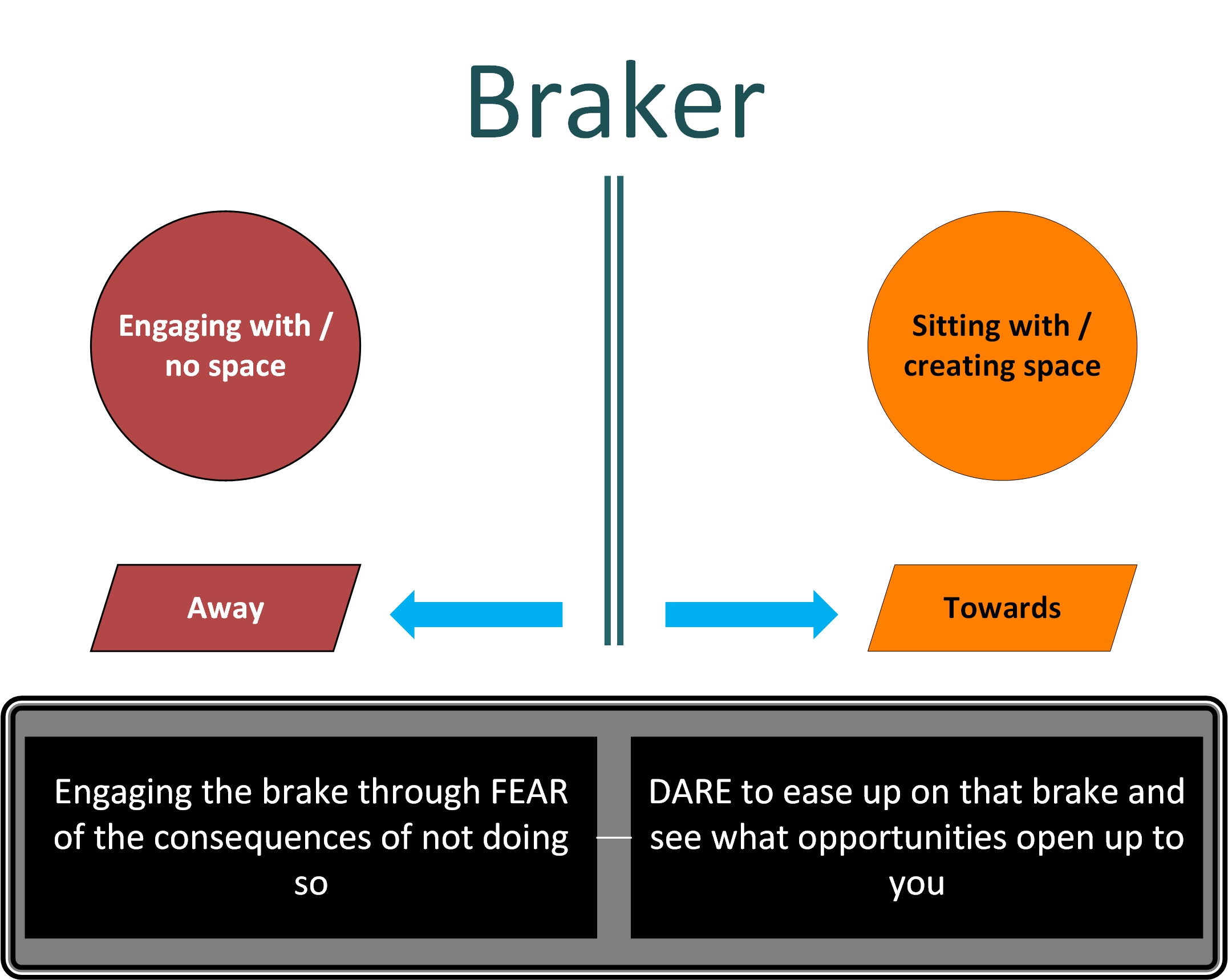
Pressing the Brake and Accelerator at the same time is not usually helpful.
Avoiding feeling bad (avoiding experience) and getting caught up in our thoughts and emotions (fusion) are what often hold us back from living in line with our values.
The following short YouTube video Headstuck! explains it all very well.
In ACT we use the FEAR and DARE acronyms (developed by Russ Harris):
F: Fusion
E
: Excessive Goals
A: Avoidance of discomfort
R
: Remoteness from Values
D: Defusion
A
: Acceptance of discomfort
R: Realistic goals
E
: Embracing Values
It takes courage to turn towards what is bothering us. Sit with the discomfort. Be with it in the moment. Examine it with openness and curiosity. THIS IS ULTIMATE ACCEPTANCE.
